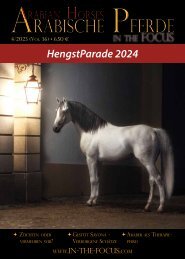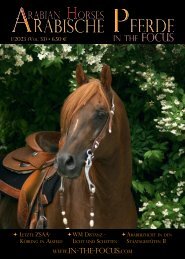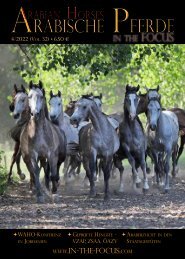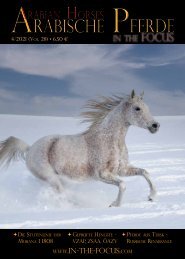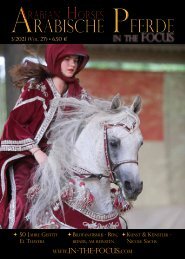Sie wollen auch ein ePaper? Erhöhen Sie die Reichweite Ihrer Titel.
YUMPU macht aus Druck-PDFs automatisch weboptimierte ePaper, die Google liebt.
Shagya-Arabian International<br />
on Inspections USA<br />
Tour in<br />
The Performance Shagya-Arabian Registry<br />
(PShR) held last year's inspection early<br />
October at the Stafford Farm in Pleasant<br />
Plains, Illinois. Altogether seven horses, mares<br />
and geldings, were registered. The inspection<br />
included a veterinary examination, an exterior<br />
judgement, then free jumping, rideability test<br />
and interior test.<br />
The farm is located near to Springfield, the state<br />
capital of Illinois. Springfield is a famous historical<br />
place in the U.S., as the city is known as the<br />
home of Abraham Lincoln. Since the schedule<br />
wasn't too busy, we even had the opportunity<br />
to visit the very informative Abraham Lincoln<br />
Presidential Museum.<br />
Thorough Examination<br />
For the veterinary examination, all horses lined<br />
up and all went through the proper tests by Dr.<br />
Scott Austin of the University of Illinois. Most of<br />
the exams were on Saturday with the exterior<br />
judgement in the morning and the rideability<br />
test and the free jumping in the afternoon. The<br />
test rider was Martha Rattner, the 2015 Horseperson<br />
of the Year in the U.S. Inspection judges<br />
were Marie Johnson, "R" Judge for USDF and<br />
Judit Erzsébet Kovács, the registrar of the "Society<br />
of the Hungarian Arabian Horse Breeders"<br />
(MALE).<br />
The horses were well prepared for the tests.<br />
They were very attentive to their handlers and<br />
did a good job during the in-hand showing. It<br />
was obvious to see that they were mostly ridden<br />
in endurance riding, but they also showed<br />
diligent cooperation in free jumping and in<br />
the rideability exercises. The tests were judged<br />
mostly within the category ‘good’ and all horses<br />
passed the inspection.<br />
The side-program included presentations for<br />
both evenings: the first evening Judit Kovács<br />
gave a short summary on the history of the<br />
Shagya-Arabians and on the following day Dr.<br />
Olivia Rudolphi and Martha Rattner gave a<br />
talk on the events and their experiences at the<br />
Young Riders Endurance World Championships<br />
in Verona, Italy. Thereafter, as a surprise, the<br />
guests were offered Hungarian dishes at the<br />
Breeders’ Evening.<br />
1/<strong>2018</strong> - www.in-the-focus.com<br />
Further Education is Required<br />
As a part of education on the breed, PShR also<br />
organized a learner-judge course parallel to<br />
the inspection, in which three enthusiastic learner-judges<br />
took part: Lucy Stafford, Sherry<br />
Aune and Alex Uspenski. Before the Inspection,<br />
a large booklet was prepared so that the Learner<br />
Judges would be familiar with Inspection<br />
procedures and scoring.<br />
The next day, the Interior Test was held. The<br />
PShR had already included this test into the<br />
program of the previous inspections according<br />
to the recommendations of the ISG. Accordingly,<br />
a beautiful obstacle course was<br />
built with a pallet, cordon line, some umbrellas,<br />
a drum, with some contact obstacles and<br />
even a pool with water (which was optional).<br />
The horses performed the course mostly calm,<br />
with trust towards their handlers. Throughout<br />
the weekend, time was allowed for educational<br />
discussion and questions from the participants.<br />
The Learner Judges were very enthusiastic<br />
about the opportunity to learn from the<br />
experienced staff of judges available.<br />
It was nice to see that the quality of the Shagya-Arabians<br />
in the U.S. is very much at the<br />
same level as it is in Europe. It particularly praises<br />
the work of the breeders, if we just think on<br />
the fact that the breeding stock and the number<br />
of the stallions are much smaller overseas.<br />
I took the opportunity to inquire about what<br />
could be the biggest support for U.S. breeders<br />
from Europe and I've learned the following:<br />
First, communication was mentioned – they<br />
would like to read more specialized breeding<br />
literature in English. They would be interested<br />
in bloodlines, the genetic results of melanoma<br />
research, the latest news on inspections<br />
and shows in Europe, and notice of upcoming<br />
events to allow for trip planning from the U.S.<br />
They also mentioned updating communication,<br />
such as organizing video conferences, posting<br />
up-to-date information on Facebook, and<br />
mobile-friendly websites where breeders could<br />
be educated, inspection results presented<br />
61<br />
Looking for Contacts in Europe<br />
Sport Achievements<br />
Shagya-Arabians are known as elegant riding<br />
horses with endurance and good rideability.<br />
In the US they prove that with their results: the<br />
Shagya Sporthorse mare Lily Creek Rhythm<br />
received the special award for a lifetime performance<br />
of 1600 distance miles (2575 km).<br />
Owner and rider of this high-performing mare<br />
is Sherry Aune. The PShR recognizes Shagya<br />
Sporthorses (must be 25% Shagya-Arabian) in<br />
order to help promote and educate people on<br />
the benefits of the Shagya-Arabian.<br />
Another outstanding sport achievement was<br />
recognized for the Shagya-Arabian gelding SA<br />
Te Jat. This horse, owned by Chris and Marty<br />
Power, has already made more than 3000 miles<br />
(4830 km) in endurance riding competition.<br />
The most beautiful of these performances was<br />
to see that both horses were in a good physical<br />
condition as well as in good temperament. For<br />
me, this was a sign of species-appropriate horse<br />
treatment and usage, on which the Members<br />
of the PShR attach great importance. Performance<br />
testing is emphasized in the goals of the<br />
PShR – thus, the horses have a chance to show<br />
their genetic potential, including the geldings<br />
and sporthorse outcrosses.<br />
After lunch, the participants left for home with<br />
their horses – since they all arrived to the inspection<br />
from a greater distance, as far away<br />
as six hours of driving. It was a thoroughly<br />
prepared and excellently organized inspection<br />
where all the Team Members of the PShR<br />
did their best. I had the impression that the<br />
Shagya-Arabians and the Shagya sporthorses<br />
in the U.S. have a good and well deserved reputation.<br />
Judit Erzsébet Kovács<br />
along with photos, and other news. The PShR<br />
would like to promote the ISG and the international<br />
efforts of all the ISG members to promote<br />
the lovely Shagya-Arabian. At present, the<br />
ISG is largely unknown in the U.S. and Canada.<br />
From the breeding perspective it is a challenge<br />
to expand the selection of stallions in the U.S.<br />
due to the limited gene pool. So as to make<br />
this possible, the PShR has set up a kind of databank<br />
for frozen semen on the PShR website.<br />
There are two categories: one for the stallions<br />
that already have frozen semen approved<br />
for U.S. import and the second is for stallions<br />
whose owners would be willing to process<br />
frozen semen for U.S. importation if there was<br />
interest. It could be a modern and quick solution<br />
if more stallion owners in Europe were<br />
interested.<br />
I hope that it can be done and also the American<br />
breeders could have a wider base for stallions<br />
- because they deserve it! J. Kovacs<br />
Shagya-Araber



